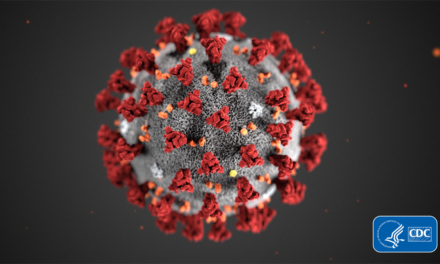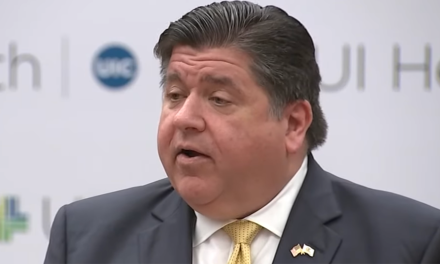
On the record with Stefan Green, director of the Genomics and Microbiome Core Facility at Rush University Medical Center

Funded by a $3.5 million grant from the Chicago Department of Public Health, Rush University Medical Center is launching a genome sequencing lab to help public officials understand the prevalence of new strains of COVID-19. The lab is part of a national push to gain a better grasp on the impact and spread of new variants, some of which may be more contagious and more resistant to approved vaccines.
As of last week, there have been nearly two dozen confirmed cases in Illinois of a variant first detected in the United Kingdom, and at least one case of a strain discovered in South Africa.
Health News Illinois talked Thursday with Stefan Green, director of the Genomics and Microbiome Core Facility at Rush, about his new lab, why the U.S. is lagging other countries in COVID-19 genome sequencing and how a shortage of supplies could hamper a national ramp-up of the efforts.
Edited excerpts are below.
HNI: How will genome sequencing help inform the city’s response to COVID-19?
Stefan Green: Early on in the pandemic you really only needed to know whether somebody had COVID or not. And now we know that that information alone is not enough. Now we need to be aware of: Do people have COVID? Where do people have COVID, and also which strain of COVID do they have? Are they across the entire city? Are they starting in one area and spreading to other parts of the city? These are all data that the new laboratory can generate for the city that can then be used to devise appropriate public health responses.
And it’s more than just the laboratory processing specimens. The idea is also to have data scientists and epidemiologists and virologists on the Rush side interfacing with similar scientific expertise on the city side. And that kind of brainpower can then help make decisions. You know, should we allow indoor dining, those sorts of things …
It’s also exceedingly important that we monitor for new variants that we don’t know about yet. We’re aware of the variants that were initially identified in the UK and South Africa and in Brazil. But there’s no reason we can’t get new variants that are developing. And certainly as the rates of vaccination increase, we are also very interested in monitoring which strains continue to circulate, even after vaccination rates have gone up. And all of those will be used to inform the public health response at the city wide level. The most important piece, at least from my perspective, is to get proper data that can be used for making decisions. We need an appropriate sampling regime and a sufficient number of genomes sequenced so that the city can make proper decisions going forward.
HNI: Are you coordinating with other labs?
SG: It is obviously part of a much broader effort across the country to greatly increase the ability to do COVID whole genome sequencing. And I think those data are really valuable of course on a local scale, but are also extraordinarily important when integrated across the entire country. So the idea is to share any sequence data with the (Centers for Disease Control and Prevention) and with other publicly accessible data repositories so that we can understand both at a regional scale and also at a countrywide scale and a global scale, for example, ‘Where do we think the first point of access into the United States is for a new variant? Where are they spreading most rapidly?’ If there are new variants in other locations we want to know about it so that we can start making sure that we’re ready to identify those when they get here and same thing if we identify something in Chicago, it’s useful elsewhere … This is an all-hands-on-deck scenario. We don’t view other labs in competition with us. We need everybody on board. We think it’s a great thing to have other locations also sequencing.
HNI: Public health experts say we need to sequence at least 5 percent of positive cases in order to gain a good understanding of where strains are spreading, and where new ones are emerging. What’s the initial capacity of your lab?
SG: The initial mandate from (the Chicago Department of Public Health) has been for 6,000 genomes for the first year. So, that certainly won’t get us to the 5 percent level. We have been discussing with the city ways that we can increase the number of samples that we’re processing so that we can increase that number. And what we’re thinking, this is not a fully baked idea yet, but we’re looking for intermediates in between simply doing a quantitative PCR test – your nasopharyngeal swabs from CVS or Walgreens that will tell you, ‘Yes, you’ve got COVID’ or ‘No, you don’t have COVID.’ That’s very useful, but that’s low information in the sense it’s just presence or absence. And then you’ve got whole genome sequencing, which is high information density. It tells you exactly every variant position across the genome. And we’re thinking about something intermediate between those two that will allow us to process more samples, give us somewhat more information than just yes or no, but be less expensive so that we can process more samples. The technical term we would use is genome typing of the virus, meaning that we’re looking for specific variants that we know about using high throughput assays rather than the whole genome sequencing.
Also, one of the things I’m trying to do in the laboratory is build as much automation and also instrumentation that can miniaturize the reactions, which means we can use smaller amounts of reagents, which can reduce the cost and that should also hopefully be able to increase the number of samples that we could process. So I think it’s going to be ongoing, but my expectation is we’ll start a bit slow. And then as we go along, we’ll be able to do more and more samples. And in discussions with the city we will be able to decide which is the right ratio of samples – from low information to high information, from low cost to high cost.
HNI: Nationally, some labs have faced difficulty getting enough supplies to ramp up their work. How much of an issue is that for Rush as you get this off the ground?
SG: We’re modestly nervous about it. For example, we’ve ordered a minus 80 freezer as part of the new laboratory. Those are about six to eight weeks delayed in terms of turnaround time. We have other freezers here at Rush but we need a dedicated instrument for the laboratories. So that’s one thing. We definitely are seeing when we talk to different suppliers that some of the plastics, some of the consumables like pipette tips, are back-ordered, or there’s a supply limitation. So we’re trying to put in orders now and they’re telling us ‘OK, we can give X amount now and then we’ll deliver more later.’ I think they’re trying to avoid one customer trying to buy everything and then wiping out the ability of other labs.
I talked to one lab doing COVID sequencing, and they said they’d actually bought two different instruments for processing samples for RNA extraction – that’s the first stage in the workflow – just so that they would have two different suppliers for their plastic so if they had a limitation on one then they may be able to still depend on the other. We’re also discussing with some companies that have reagents that basically allow you to do some analyses without doing a full RNA extraction. And in those cases, you don’t need as much plastics for the workflow. We’re hoping that can help stave off some of these limitations.
So it is a concern. I don’t think it’s as bad as it was maybe a few months ago. But, you know, when everybody is trying to do very similar things there can be an issue. We haven’t seen any issues yet on the sequencing side. The actual sequencing kits seem to be OK for the moment. It seems like the bottlenecks are really at the freezers, and then maybe at the RNA extraction stage. And then also at the plastic tips for pipettors. Those are the three areas that we’re most concerned with.
HNI: Why is the U.S. lagging other countries in the genome sequencing of COVID-19?
SG: I’ve got two answers for you. First, we also have the world’s largest outbreak. So, I was talking to somebody else and they said, ‘Well look, if you’re New Zealand, you could do 100 percent of the people who have had COVID because they have had like 100 cases.’ So it’s a little bit misleading when you just go by percentages because we’ve had so many cases. The other is, look, I don’t think anyone will suggest that in the prior year to this one, the pandemic was managed particularly well at a government level. And, you know, to do a whole genome sequencing approach is not a cheap endeavor. And while there are many, many labs across the country, academic facilities, companies that can do it, you really need a concerted government action. You need a nationwide plan that’s informed by epidemiologists and public health experts. You need an all-hands-on-deck scenario. And that requires organization and a will and an understanding that these kind of data are essential. I think that was lacking …
And I think now there is the realization of these variants and how scary the variants seem to be. Or at least the possibility that they’re going to have higher mortality rates or they are going to evade the immune response associated with vaccinations. I think that is also triggering a greater interest in doing the whole genome sequencing now. Because what the whole genome sequence data are essential for is to look at these strain levels circulating in communities.









